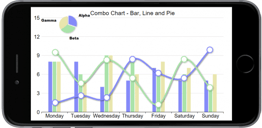Mobile-first development means designing an experience for mobile devices first before doing it for desktops or laptops. But going mobile-first isn’t as easy as it sounds.
Mobile-first development has long passed the realm of hype, and is paying off big-time for many companies. In its most recent first quarter earnings results, for example, PayPal reported its mobile payment volume increased 51% compared to the same period a year ago, and is now $32 billion. That’s 32% of all PayPal revenue. A statement from PayPal notes: “PayPal’s mobile-first approach to product development is driving increasing engagement across the platform.”
Mobile-first development means designing an experience for mobile devices first before doing it for desktops or laptops. But going mobile-first isn’t as easy as it sounds, and if you’re not careful, you can get it wrong.
How to Know If You're Doing Mobile First Design the Right Way
John Beale, Media Manager at Pernod Ricard, and managing director of the firm Eight Thinking, offers solid advice in a blog post on how to get mobile-first development right.
First, he recommends, design for a mobile platform that’s ubiquitous across your target audience. More often than not, he says, that means starting with a web site rather than a mobile app.
Once you’ve done that, don’t think that merely designing a “responsive” web site is the same as designing a mobile-first one. A responsive web site is one that scales and accommodates itself to different size screens, so it’s suitable for them all. But responsive design often simply hides elements on smaller screens, and doesn’t design primarily for mobile. So you need to go all in, and design for mobile devices first.
Next, he says, “Produce mobile-friendly content — Nobody wants to watch your 3-minute how-to video.” Producing mobile-friendly content also means using lower-quality videos, smaller images, and shorter articles and other content.
Now, make sure that you “enable all your other channels through mobile first.” That means features such as a click-to-call link, social sharing, and directions using a map interface. This keeps a mobile-first development approach moving forward properly.
 Finally, he says, use the mobile phone as the identifier and contact for your customer. That means using SMS to contact them, for example, as well as other ways, including web logins.
Finally, he says, use the mobile phone as the identifier and contact for your customer. That means using SMS to contact them, for example, as well as other ways, including web logins.
Beale stops his mobile-first recommendations there, but we have another: Rather than taking a desktop apps and pushing it to mobile, consider using your mobile website -- or web app -- as the foundation for building future mobile apps with a mobile-first design.
That’s precisely what you get with Alpha Anywhere: Write once, and deploy it everywhere. Many of our customers deploy a web app FIRST, then use what they learn to deploy a well-designed mobile app.
Read how a leading manufacturer of heating, ventilation and air conditioning products built web and mobile apps in one month with Alpha Anywhere.
Watch our responsive app design webinar or read how our CTO approached mobile first needs with responsive app design and a related responsive app design website. For a different but related approach, read this blog on "offline-first" mobile app design and development.
Read Beale’s full blog.




Comment